Tucson Citizen
Tuesday, March 30, 2004
Migrants jam holding pen

|
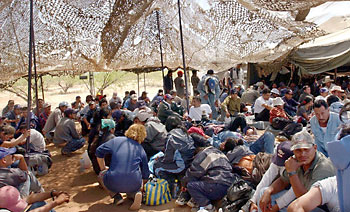
|
Newly arrived illegal immigrants join
others in the compound, which is equipped
with a misting system. Military-type
tarps shield immigrants from the sun.
|
Illegal immigrants often wait for hours at
BSI to get on a
bus to detention centers where they are processed
before
being taken to Nogales, Son. |
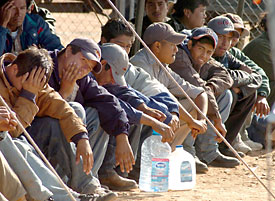
|
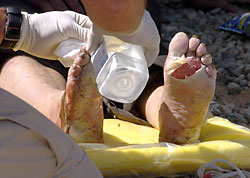
|
A bus can carry only 55 passengers and often
hundreds await processing. |
BORSTAR agent Gary Widner treats the
blistered feet of a 53-year-old man who walked
more than 12 hours. He was transported to
a
hospital. |
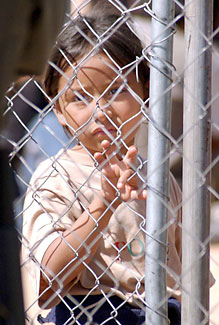
|
The wait for transportation to
detention centers takes hours. |
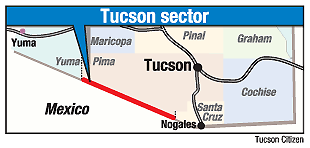
Up to 500 at a time temporarily held in 3,000-square-foot facility
GABRIELA RICO
Border Patrol agents are busting illegal immigrants faster than they
can ship them to processing centers, cramming a temporary holding facility
with as many as 500 detainees at a time.
Since Jan. 1, the agency's Tucson sector has seen a 50 percent increase
in the number of illegal immigrants caught compared to the same period
last year.
And out in the middle of nowhere a temporary holding area designed to
get migrants out of the sun and agents back in the field quickly is jammed
full.
Day and night, buses ferry 55 people at a time to detention centers
for processing, a minimum three-hour round trip. But they can't keep up
with the growing numbers.
The holding area, referred to as the Border Security Initiative, is
in a remote part of the Tohono O'odham Nation. The tribe's legislative
council agreed to the placement.
The roughly 3,000-square-foot area, defined by a temporary fence, has
portable bathrooms and military-style tarps for shade.
Large fans attached to a misting system blow cool air onto detainees,
and a 320-gallon tank provides drinking water.
Crackers are the only food available because the center was intended
for stays of only three to four hours, said Jason Lowery, a Border Patrol
supervisor.
But in the past month, the BSI has been packed with 300 to 500 people
waiting for buses to haul them to Casa Grande, Tucson or Nogales for processing,
Lowery said.
"Productivitywise, this gives the agents a way to get back out to the
field quickly," said Mark Norris, a Border Patrol field operation supervisor.
Along with two regular agents, at least one EMT-certified Search, Trauma
and Rescue agent is assigned there, Lowery said.
That's important for the BSI, said BORSTAR Commander Ron Bellavia.
"There are people in the desert in need of medical care and rescuing,"
he said. "(BSI) takes a lot of stress off of the local EMS and hospital."
Because it is near the border, the BSI also is a staging area for search-and-rescue
missions, Bellavia said.
Lowery said that despite the high number of detainees, "It's been peaceful."
Detainees crowd into shaded areas and nap, play with the children or
share a few laughs.
One day last week, the population hit 157 by 9 a.m. Forty-five minutes
later, a convoy of Border Patrol vans delivered 54 people. When a bus arrived,
it brought more than a dozen people who had surrendered on the side of
the road.
Two more Jeeps and another van appeared, and by the time the detention
bus left at 10 a.m. with 55 people, the population at BSI was 226.
Eager to get out, detainees rush to the fence when they see a bus arrive.
Agents grab 55 pieces of paper with names on them from the bottom of
a stack and begin a roll call. One by one, people scurry from behind the
fence, grab their backpacks and jump on the bus.
When no more names are called, those left behind offer each other consoling
pats on the back.
"Maybe the next one," one man tells another as they head for the shade
to wait.
One man stumbles to the fence, complaining of pain.
BORSTAR agent Gary Widner pulls him aside for an examination. After
removing the man's shoes and socks, Widner discovers that the 53-year-old
has blisters covering the length of his feet, which cannot be tended to
there.
"His soles are gone," Widner says while washing the man's feet.
An ambulance takes the man to a hospital, where agents estimate he will
need at least a week to recover from his 12-hour walk in flimsy tennis
shoes through rugged terrain.
As another loaded bus leaves BSI, the driver waves to incoming Border
Patrol agents who are dropping off more illegal immigrants.
The wait gets longer, and by 11 a.m., the number of detainees reaches
279. Two hours later, the number has swelled to 315.
Meanwhile, the radio buzzes with calls from agents in the field who
have caught large groups of illegal immigrants and need help transporting
them to BSI.
"We have a group of 60 and a group of 28 coming in," Lowery says with
a sigh
As of Saturday, 62,946 illegal immigrants were caught or surrendered
to Border Patrol agents in the Tucson sector in March, according to agency
statistics.
Since the beginning of the year, 141,792 illegal immigrants have been
caught in the Tucson sector, compared to 94,772 in the same period last
year.
"This (BSI) is not the answer," said a 52-year-old man from Michoacan,
who declined to give his name because he said he was preparing to cross
the border again next week.
His travel partner Jesus Garcia, 50, chuckled.
"Well, it's not fancy, but it's their right to hold us here," he said.
"If they had asked my opinion, I assure you we wouldn't be here."
In June, a modular structure will take the place of the BSI and will
double as a substation for the O'odham police department, Lowery said.
The new facility will have computers for background checks to determine
if someone is eligible for voluntary return to Mexico. That will give agents
the ability to bypass a trip to a detention center so the migrants can
be taken directly to Nogales, Son.





